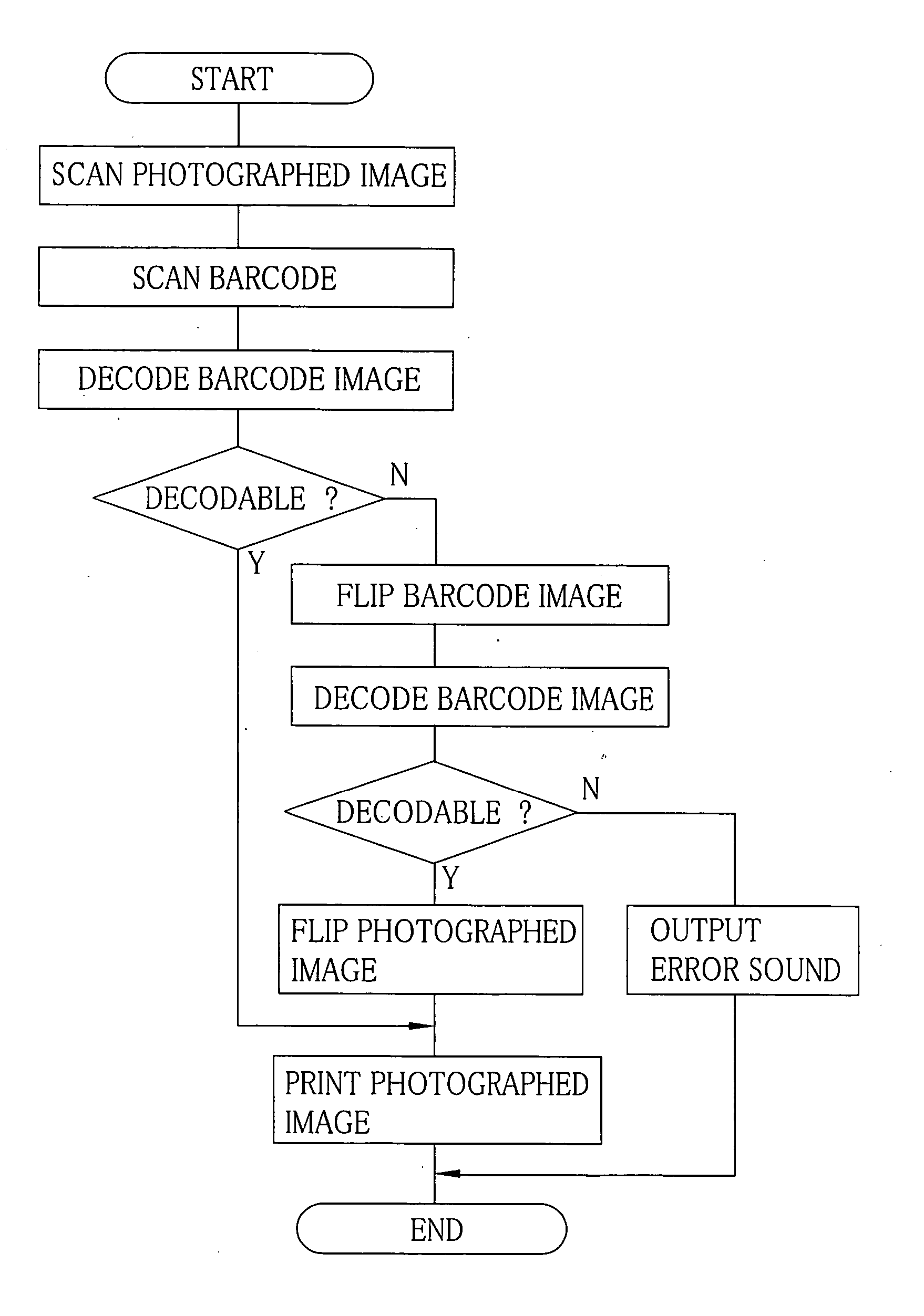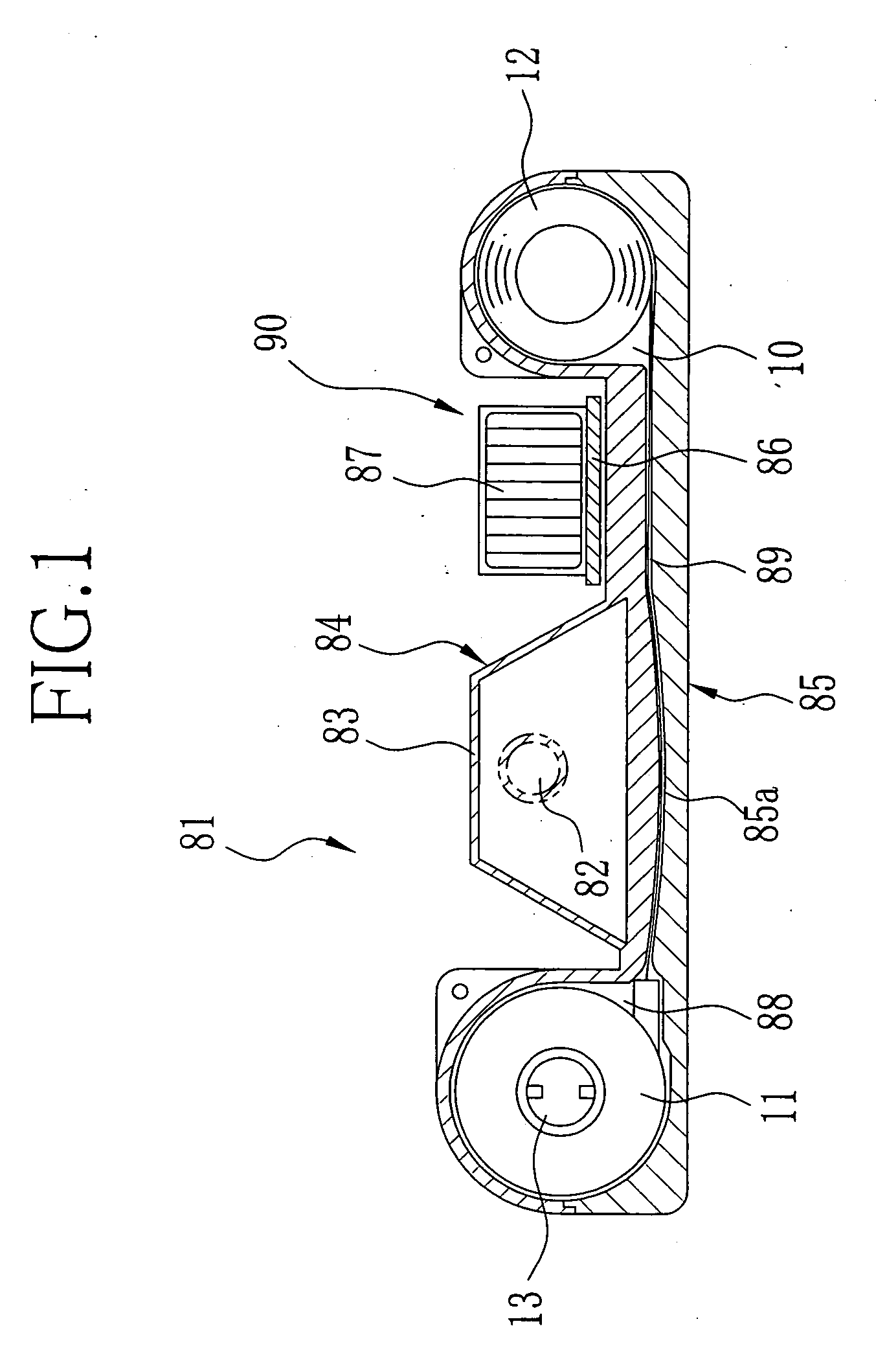Method for printing a developed photo film
a technology of developed film and developed film, which is applied in the direction of printers, instruments, camera body details, etc., can solve the problems of high manufacturing cost and the inability to provide magnetic or optical recording devices in the lens-fitted photo film unit, and achieve the effect of preventing reverse printing and low cos
- Summary
- Abstract
- Description
- Claims
- Application Information
AI Technical Summary
Benefits of technology
Problems solved by technology
Method used
Image
Examples
first embodiment
[0072] (First Embodiment)
[0073] Referring to FIG. 10, the viewfinder 51 comprises a negative meniscus lens Lll as the objective lens element, a biconvex lens L12 as the first eyepiece lens element, and a positive meniscus lens L13 as the second eyepiece lens element. The focal length of the objective lens element L11, the first eyepiece lens element L12, and the second eyepiece lens element L13 is denoted as F11, F12, and F13, respectively. The values of F11 to F13 are as follows:
F11=−15.77 mm
F12=41.88 mm
F13=203.33 mm
[0074] Table 3 shows lens data of the viewfinder 51. The same abbreviations as Table 1 are used in Table 3.
TABLE 3RCASRIDPFirst Surface56.3141.601.58529.9Second Surface*7.84316.93Third Surface65.1592.761.58529.9Fourth Surface*−38.65422.11Fifth Surface−19.2381.601.58529.9Sixth Surface*−17.068
[0075] In Table 3, Radius of Curvature (RC) and Air Space (AS) are expressed in millimeter (mm). Refractive Index (RI) and Dispersive Power (DP) are obtained with respect to D line...
second embodiment
[0081] (Second Embodiment)
[0082] Referring to FIG. 11, the viewfinder 52 comprises a negative meniscus lens L21 as the objective lens element, a biconvex lens L22 as the first eyepiece lens element, and a negative meniscus lens L23 as the second eyepiece lens element. The focal length of the objective lens element L21, the first eyepiece lens element L22, and the second eyepiece lens element L23 is denoted as F21, F22, and F23, respectively. The values of F21 to F23 are as follows:
F21=−16.35 mm
F22=38.198 mm
F23=−500.34 mm
Accordingly, the refractive power of the first eyepiece lens element L22 is larger than the absolute value of the refractive power of the second eyepiece lens element L23.
[0083] Table 5 shows lens data of the viewfinder 52, and Table 6 shows aspheric coefficients.
TABLE 5RCASRIDPFirst Surface88.6921.601.58529.9Second Surface*8.57622.95Third Surface2619.5683.001.58529.9Fourth Surface*−22.52915.85Fifth Surface−19.7951.601.58529.9Sixth Surface*−21.865
[0084]
TABLE 6Secon...
third embodiment
[0087] (Third Embodiment)
[0088] Referring to FIG. 12, the viewfinder 53 comprises a negative meniscus lens L31 as the objective lens element, a positive meniscus lens L32 as the first eyepiece lens element, and a negative meniscus lens L33 as the second eyepiece lens element. The focal length of the objective lens element L31, the first eyepiece lens element L32, and the second eyepiece lens element L33 is denoted as F31, F32, and F33, respectively. The values of F31 to F33 are as follows:
F31=−16.79 mm
F32=36.63 mm
F33=−200.00 mm
Accordingly, the refractive power of the first eyepiece lens element L32 is larger than the absolute value of the refractive power of the second eyepiece lens element L33.
[0089] Table 7 shows lens data of the viewfinder 53, and Table 8 shows aspheric coefficients.
TABLE 7RCASRIDPFirst Surface72.9021.601.58529.9Second Surface*8.59025.49Third Surface−2386.2483.001.58529.9Fourth Surface*−21.24913.31Fifth Surface−25.2391.601.58529.9Sixth Surface*−32.934
[0090]
TA...
PUM
| Property | Measurement | Unit |
|---|---|---|
| size | aaaaa | aaaaa |
| focal length | aaaaa | aaaaa |
| half-field angle | aaaaa | aaaaa |
Abstract
Description
Claims
Application Information
 Login to View More
Login to View More - R&D
- Intellectual Property
- Life Sciences
- Materials
- Tech Scout
- Unparalleled Data Quality
- Higher Quality Content
- 60% Fewer Hallucinations
Browse by: Latest US Patents, China's latest patents, Technical Efficacy Thesaurus, Application Domain, Technology Topic, Popular Technical Reports.
© 2025 PatSnap. All rights reserved.Legal|Privacy policy|Modern Slavery Act Transparency Statement|Sitemap|About US| Contact US: help@patsnap.com



